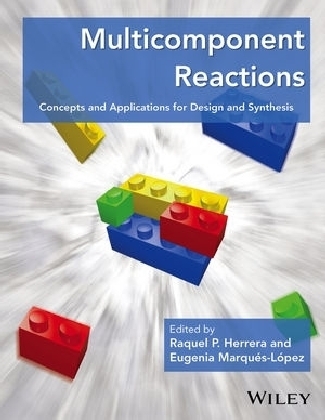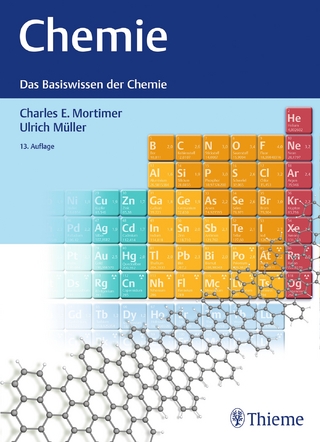
Multicomponent Reactions
John Wiley & Sons Inc (Verlag)
978-1-118-01600-8 (ISBN)
- Lieferbar (Termin unbekannt)
- Versandkostenfrei innerhalb Deutschlands
- Auch auf Rechnung
- Verfügbarkeit in der Filiale vor Ort prüfen
- Artikel merken
Addressing a dynamic aspect of organic chemistry, this book describes synthetic strategies and applications for multicomponent reactions – including key routes for synthesizing complex molecules.
• Illustrates the crucial role and the important utility of multicomponent reactions (MCRs) to organic syntheses
• Compiles novel and efficient synthetic multicomponent procedures to give readers a complete picture of this class of organic reactions
• Helps readers to design efficient and practical transformations using multicomponent reaction strategies
• Describes reaction background, applications to synthesize complex molecules and drugs, and reaction mechanisms
Raquel P. Herrera, PhD, is Tenured Scientist of the Spanish National Research Council (CSIC) at the ISQCH-University of Zaragoza. Her research interests are focused on asymmetric organocatalysis and its applications. Eugenia Marqués-López, PhD, is an assistant professor at the University of Zaragoza. She performs her research on new catalytic methods, mainly based on asymmetric organocatalysis at the Institute of Chemical Synthesis and Homogeneous Catalysis (ISQCH-CSIC).
List of Contributors xii
Preface xiii
List of Abbreviations xv
1 Introduction: Multicomponent Strategies 1
General Introduction 1
1.1 Basic Concepts 3
1.1.1 Clarifying Terminology: One]Pot, Domino/Cascade, Tandem, and MCRs 3
1.1.2 Using Rational Design to Discover New MCRs 3
1.1.3 Discovering New MCRs with Automated Combinatorial Reaction Finding 5
1.1.4 Computational and Analytical Tools to Study MCRs 7
1.1.5 Diversity]Oriented Synthesis and Biology]Oriented Synthesis 7
1.1.6 Optimization of MCRs 7
1.2 Catalysis in MCRs and Various Synthetic Approaches 8
1.2.1 Organocatalysis in MCRs 8
1.2.2 Organometallic Catalysis in MCRs 8
1.2.3 Biocatalysis in MCRs 8
1.2.4 Combining Different Types of Catalysis 8
1.2.5 Other Methods 9
1.3 Green Chemistry 10
1.3.1 Atom Economy 10
1.3.2 Using Green Solvents 11
1.3.3 Solventless MCRs 11
1.3.4 Heterogeneous Catalysis in MCRs 11
1.4 Importance and Evolution 12
References 12
2 Organocatalytic Asymmetric Multicomponent Reactions 16
2.1 Introduction 16
2.2 Three]Component Mannich Reaction 17
2.3 Cycloaddition Reaction 26
2.4 Organocatalytic Multicomponent Domino Asymmetric Reactions 29
2.4.1 Michael]Type Multicomponent Process: Cyclic Carbon Frameworks 30
2.4.2 Miscellaneous Domino Reactions 49
2.5 Development of Drug Intermediates 58
2.6 Miscellaneous Reaction 65
2.7 Conclusions 66
References 66
3 Metal]Catalyzed Multicomponent Reactions 72
3.1 Introduction 72
3.2 Palladium]Catalyzed Mcrs 72
3.2.1 Palladium]Catalyzed Carbonylation Reactions 72
3.2.2 Palladium]Catalyzed Mcrs Involving Isocyanides 74
3.2.3 Carbopalladation of Unsaturated CC π]Components 76
3.2.4 Amines as Building Blocks 80
3.3 Nickel]Catalyzed Mcrs 83
3.3.1 Nickel]Catalyzed Cross]Trimerization of Alkynes 83
3.3.2 Nickel]Catalyzed π]Systems Couplings 86
3.3.3 Ni]Catalyzed Reductive Conjugate Addition 88
3.4 Group 11 Metal]Catalyzed Mcrs 91
3.4.1 Copper]Catalyzed Azide–Alkyne Cycloaddition 91
3.4.2 A3]Coupling 94
3.4.3 Miscellaneous 101
3.5 Rhodium]Catalyzed Mcrs 101
3.5.1 Rhodium]Catalyzed Mcrs via Onium Ylide Intermediates 101
3.5.2 Rhodium]Catalyzed Three]Component Cross]Addition Reactions 108
3.6 Group 8 Metal]Catalyzed Mcrs 111
3.6.1 Iron]Catalyzed Mcrs 111
3.6.2 Ruthenium]Catalyzed Mcrs 113
3.7 Conclusions 117
References 117
4 Multicomponent Reactions with Organoboron Compounds 127
4.1 Introduction 127
4.2 Catalytic Mcrs with Organoboron Compounds 127
4.2.1 Cobalt]Catalyzed Mcrs Containing Organoboron Compounds 127
4.2.2 Palladium]Catalyzed Mcrs Containing Organoboron Compounds 128
4.3 Multicomponent Assembly of Organoboron Compounds: Efficient Approach to Supramolecular Chemistry 128
4.4 Multicomponent Petasis]Borono–Mannich Reaction 132
4.4.1 Organocatalytic Enantioselective Petasis]Type Reaction 133
4.4.2 Metal]Catalyzed Four]Component PBM Reaction 134
4.4.3 Synthetic Applications of PBM 135
4.5 Allenylborates in Mcrs 140
4.6 Multicomponent Hetero]Diels–Alder/Allylboration 141
4.6.1 Chiral Catalyzed One]Pot [4 + 2] Cycloaddition/Allylboration 141
4.6.2 Polymer]Supported Mcrs 141
4.7 Palladium]Catalyzed Asymmetric Allene Diboration/α]Aminoallylation 143
4.8 Synthetic Applications of Boron]Based Mcrs 143
4.9 Conclusion 146
References 146
5 Carbene]Promoted Multicomponent Reactions 149
5.1 Introduction 149
5.2 Mcrs Involving Carbenes as Key Components 149
5.2.1 Mcrs of Dimethoxycarbenes 149
5.2.2 Mcrs of NHCs 150
5.2.3 FCCs as Reagents: Approach to Highly Substituted Carbo] and Heterocycles 158
5.3 Mcrs Involving Carbenes as Catalysts 162
5.3.1 Nhcs as Organocatalysts in Mcrs 162
5.3.2 Metal]Catalyzed Mcrs Involving Nhcs as Ligands 174
5.4 Synthetic Utility 190
5.4.1 Carbenes as Components 190
5.4.2 Nhcs as Catalysts/Ligand 190
5.5 Conclusion 193
References 193
6 Multicomponent Reactions in the Synthesis of Target Molecules 198
6.1 Introduction 198
6.2 Mcrs in Drug Discovery and for the Synthesis of Biologically Important Molecules 198
6.3 Synthesis of Natural Products in an Efficient Manner 200
6.4 Heterocycles as Key Substrates in Mcrs 205
6.4.1 Synthesis of Indoles 206
6.4.2 Synthesis of Fused Polyheterocycles 211
6.4.3 Synthesis of Spiro]Type Polyheterocyclic Compounds 217
6.4.4 Synthesis of DHPMs and Thiazines 224
6.4.5 Synthesis of Pyrroles 229
6.5 Amino Acid Derivatives by Mcrs 233
6.6 Industrial Applications 236
6.7 Conclusion 239
References 239
7 Recent Advances in the Ugi Multicomponent Reactions 247
7.1 Introduction 247
7.2 Ugi Three]Component Reactions 247
7.3 Ugi Four]Component Reactions 254
7.4 Five], Six], Seven], and Eight]Component Reactions Based on the Ugi Reaction 258
7.5 Ugi Postmodification Processes 265
7.6 Ugi–Smiles Approach 270
7.7 Ugi–Smiles Postmodification Processes 274
7.8 Conclusion 278
References 278
8 Passerini Multicomponent Reactions 283
8.1 Introduction 283
8.2 O]Alkylative and Silylative Passerini Three]Component Reactions 283
8.2.1 O]Arylative Passerini Three]Component Reactions 283
8.2.2 Metal]Catalyzed O]Alkylative Passerini Three]Component Reactions 284
8.2.3 O]Silylative Passerini Three]Component Reactions 285
8.3 Passerini 3CR Under Oxidative Conditions 286
8.3.1 Metal]Catalyzed Oxidation Passerini 3CR 286
8.4 Synthesis of Macrocycles by a Passerini Reaction 287
8.5 Enantioselective Metal]Catalyzed Passerini Reaction 290
8.6 Synthesis of Pharmacologically Important Peptidomimetics 292
8.7 Multicomponent Passerini Approach to Important Targets 293
8.8 α]Hydroxycarboxamide, an Important Intermediate for Chemical Synthesis 297
8.9 Passerini 3CR under Eco]Friendly Reaction Conditions 299
8.9.1 Aqueous Media 299
8.9.2 Ionic Liquids and Peg 299
8.9.3 Solvent]Free Conditions 300
8.9.4 MW]Assisted Passerini Reaction 300
8.10 Conclusions 301
References 302
9 Biginelli Multicomponent Reactions 306
9.1 Introduction 306
9.2 Mechanism 306
9.3 Chiral Lewis] and Brønsted Acid]Catalyzed Biginelli Reactions 308
9.4 Brønsted Base]Catalyzed One]Pot Three]Component Biginelli]Type Reactions 310
9.5 Organocatalytic Enantioselective Biginelli Reactions 311
9.5.1 Chiral Brønsted Acid]Organocatalyzed Biginelli Reactions 311
9.5.2 Aminocatalyzed Biginelli Reactions 313
9.6 Variations of the Traditional Biginelli Condensation 318
9.7 Heterocycles beyond the DHPMs 318
9.8 Important Targets 319
9.9 Conclusion 325
References 325
10 Bucherer–Bergs And Strecker Multicomponent Reactions 331
10.1 Bucherer–Bergs Reaction 331
10.1.1 Introduction 331
10.1.2 Comparative Stereochemical Course 331
10.1.3 Synthesis of Five]Membered Heterocycles 331
10.1.4 Metal]Catalyzed Synthesis of Hydantoin Derivatives 334
10.1.5 Modified Bucherer–Bergs Reaction 336
10.1.6 Synthesis of α]Amino Acids via Hydantoin Intermediate 338
10.1.7 Synthesis of Diaminodicarboxylic Acids 339
10.2 Mc Strecker Reaction 340
10.2.1 Introduction 340
10.2.2 MC Strecker Reaction Using Aldehyde 341
10.2.3 Strecker]Type Reaction Using Ketones 344
10.2.4 Catalyst]Free Strecker Reactions in Water 344
10.2.5 Catalyst]Free Strecker Reactions under Solvent]Free Conditions 347
10.2.6 Metal]Catalyzed Strecker]Type Reaction 348
10.2.7 Organocatalytic Mc Strecker Reaction 348
10.2.8 Efficient Heterogeneous Catalysis for the Synthesis of α]Aminonitriles 351
10.2.9 Synthetic Utility 351
10.3 Conclusions 352
References 352
11 Unusual Approach for Multicomponent Reactions 358
11.1 Zeolite]Catalyzed Mcrs 358
11.1.1 Heterogeneous Hybrid Catalyst 358
11.2 Mw]Assisted Three]Component Reactions 359
11.2.1 Synthesis of Natural Products 361
11.3 Ionic Liquid]Promoted Mcrs 363
11.4 Mcrs under Solvent]Free Conditions 364
11.5 Mcrs in Aqueous Media 370
11.6 High]Pressure Promoted Mcrs 373
11.7 Three]Component Reactions Using Supported Reagents 375
11.8 Conclusion 376
References 377
12 E ssential Multicomponent Reactions I 382
12.1 Radziszewski Reactions (Imidazole Synthesis) 382
12.1.1 Introduction 382
12.1.2 Modified Radziszewski Reactions: Efficient Tool for the Synthesis of Substituted Imidazoles 382
12.2 Sakurai Mcrs 388
12.2.1 Introduction 388
12.2.2 Synthesis of Homoallylic Ethers 388
12.2.3 Synthesis of Homoallylic Amines: Aza]Sakurai 391
12.3 Gewald Mcrs 394
12.3.1 Introduction 394
12.3.2 Easy Protocol for Synthesizing 2]Aminothiophene Derivatives 395
12.4 Kabachnik–Fields Reactions 396
12.4.1 Introduction 396
12.4.2 Straightforward Synthesis of α]Amino Phosphonates 398
12.5 Conclusion 401
References 403
13 E ssential Multicomponent Reactions Ii 416
13.1 Knoevenagel Reactions in Multicomponent Syntheses 416
13.1.1 Introduction 416
13.1.2 Domino Knoevenagel/Hetero]Diels–Alder Reaction and Pyran Syntheses 419
13.1.3 Useful Syntheses of Heterocycles: 1,4]Dihydropyridine and Diazine Syntheses 427
13.1.4 Useful Syntheses of Heterocycles: Various Heterocyclic Scaffolds 437
13.1.5 Other Knoevenagel Combinations 442
13.2 Yonemitsu]Type Trimolecular Condensations 448
13.2.1 Introduction and Mechanistic Aspects 448
13.2.2 Applications of the Original Yonemitsu Trimolecular Condensation 449
13.2.3 Yonemitsu]Type Reactions and Tetramolecular Condensations 451
13.3 Mcrs Involving Meldrum’s Acid 457
13.3.1 Introduction 457
13.3.2 Applications and DOS 458
13.3.3 Meldrum’s Acid as Synthetic Equivalent 461
13.3.4 Meldrum’s Acid as Malonic Acid Equivalent 464
13.4 Povarov Mcrs 466
13.4.1 Introduction 466
13.4.2 Mechanistic Aspects 466
13.4.3 Efficient Synthesis of 1,2,3,4]Tetrahydroquinolines 468
13.4.4 Efficient Synthesis of Quinolines 470
13.5 Hantzsch Multicomponent Synthesis of Heterocycles 472
13.5.1 Introduction 472
13.5.2 Catalysis and Mechanism 474
13.5.3 Syntheses of 1,4]Dihydropyridines and Their Oxidation to Pyridines 475
13.5.4 Multicomponent Pyrrole Syntheses 480
13.6 Conclusions 482
References 482
INDEX 496
| Verlagsort | New York |
|---|---|
| Sprache | englisch |
| Maße | 224 x 287 mm |
| Gewicht | 1420 g |
| Themenwelt | Naturwissenschaften ► Chemie ► Organische Chemie |
| ISBN-10 | 1-118-01600-9 / 1118016009 |
| ISBN-13 | 978-1-118-01600-8 / 9781118016008 |
| Zustand | Neuware |
| Haben Sie eine Frage zum Produkt? |
aus dem Bereich


